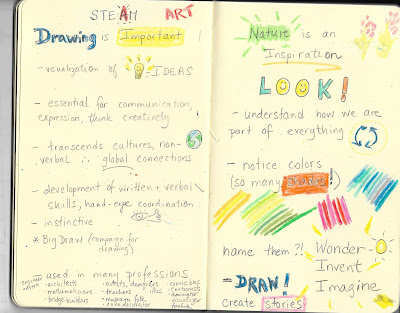To gain a fresh look at my craft, I’ve been experimenting with something that might seem counter-intuitive to writers – DOODLING.
Young children
are instinctively visually literate long before they can read. It’s only later,
when they are a bit older, that children and then adults begin to doubt their
ability to draw and convey messaging through pictures. What if, I asked myself,
I were to return to the DOODLE in an attempt to take a FRESH LOOK at things?
 Rather than
getting bogged down with the w-o-r-d-s, WHAT IF I released myself from the strictly
written form, picked up a crayon and DOODLED alongside my words?
Rather than
getting bogged down with the w-o-r-d-s, WHAT IF I released myself from the strictly
written form, picked up a crayon and DOODLED alongside my words? |
| The Doodle Revolution by Sunni Brown |
In an interview for PRINT magazine, author Sunni Brown says that by creating a doodle, "we are learning to not only sift through grains of content to find the
meaningful pieces but we are also bringing those pieces to life by
letting them live in multiple forms: a word, an image, color, a font, a
shape".
So, as a children's book author, how could I practically apply the DOODLE, I wondered?
DOODLING is a
way to free you up to think outside the box – or even to throw away the box
completely – so that you can come up with a solution to that plot problem, dream up that the missing ending, or even to come up with a whole new book idea. It can
also be a way to get you unstuck and drum up new ideas for the strategy of
being a working author.
I decided to
have a go.
One of the most
challenging aspects about creating picture books is digging deep for a unique
story that will hook in and grab young readers, then making it pacey and
concise. Starting with Debbie Ohi’s
helpful picture book page plan, I doodled the trajectory of a picture book
plot:
Next, one could
try this out on an actual picture book mentor text and eventually on your own
work in progress.
I tried it out on Lizzie Finlay's wonderful new book The (Ferocious) Chocolate Wolf:
It’s incredibly helpful to be able to SEE your picture book (and its possible flaws) if you can doodle map it out like this.
I tried it out on Lizzie Finlay's wonderful new book The (Ferocious) Chocolate Wolf:
 |
| From The (Ferocious) Chocolate Wolf by Lizzie Finlay |
It’s incredibly helpful to be able to SEE your picture book (and its possible flaws) if you can doodle map it out like this.
Then I decided
to see if I could doodle some ideas for marketing, post publication, one year
on:
After I got to
this point, I realized I needed to keep going and think about how I could
re-frame my MESSAGE in a new way. So I decided to try to DOODLE brainstorm
about two topics and themes related to my book, THE CRAYON MAN: DRAWING and
NATURE.
If I keep going, I hope to be able to relate these ideas back to my marketing plan and create new CONTENT to engage and CONNECT with new people, who might be interested in drawing and nature.
I’ve really
enjoyed flexing my creative muscles by DOODLING with coloured crayons. It's taken me to
cool new and unexpected places.
Doodling is a really cool TOOL. How can you start? Allow yourself some TIME and SPACE, a notebook or some sheets of paper, some pens, pencils and crayons. Then, choose a starting point and start. Really LISTEN . . . and HAVE FUN! Your drawings and icons don't have to be artistic. Your DOODLES can be just for you!
I was inspired to learn about doodling from experts such as Sunni Brown and Dave Gray
_______________________________________________________________________
_______________________________________________________________________











1 comment:
I really like to doodle on photos instead of making doodles from scratch. It is easier and a lot of fun too :)
Post a Comment